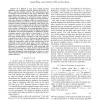Free Online Productivity Tools
i2Speak
i2Symbol
i2OCR
iTex2Img
iWeb2Print
iWeb2Shot
i2Type
iPdf2Split
iPdf2Merge
i2Bopomofo
i2Arabic
i2Style
i2Image
i2PDF
iLatex2Rtf
Sci2ools
102
Voted
IJCNN
2006
IEEE
2006
IEEE
Optimal In-Place Learning and the Lobe Component Analysis
— It is difficult to map many existing learning algorithms onto biological networks because the former require a separate learning network. The computational basis of biological cortical learning is still poorly understood. This paper rigorously introduces a concept called in-place learning. With in-place learning, every networked neuron in-place is responsible for the learning of its signal processing characteristics (e.g., efficacies of synapses) within its connected network environment. There is no need for a separate learning network. With this in-place hypothesis, consequently, each neuron does not have extra space to compute and store the second and higher order statistics (e.g., correlations) of its input fibers. This work first provides a classification of learning algorithms. Then, it shows that the two well-known in-place biological mechanisms, the Hebbian rule and lateral inhibition, are sufficient to develop orientation selective cells, similar to those found in V1,...
Related Content
| Added | 11 Jun 2010 |
| Updated | 11 Jun 2010 |
| Type | Conference |
| Year | 2006 |
| Where | IJCNN |
| Authors | Juyang Weng, Nan Zhang 0002 |
Comments (0)

